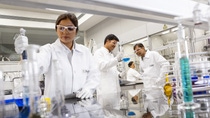Research facts and figures 2017
Who we are
Innovations for a sustainable future
Optimism is what drives all human beings. At BASF, this motivates us every day to develop solutions for the greatest challenges of our time – so we can better protect the climate, make optimal use of limited resources and provide food, energy and clean water for a booming world population.
Innovations made BASF the leading chemical company. Today our customers and the whole society are more than ever looking for innovative solutions. We all need answers for problems like climate change, scarcity of resources and marine littering. As the most innovative chemical company we take a special responsibility here, because innovations based on chemistry are key to those answers.
With our Carbon Management Program we set a benchmark in achieving the climate protection targets, with our ChemCycling approach we aim towards a circular economy. We also co-founded the Alliance to End Plastic Waste, a global effort to end plastic waste in the environment. This is how we understand our corporate purpose – "We create chemistry for a sustainable future".
Our innovative power
… is based on efficient research and development. We build on our Know-How Verbund: the great creativity, the specific skills and the broad knowledge of our networks. It is all about developing solutions together …
for a sustainable future.

Facts and figures 2020
~10,000
employees in research and development (R&D) worldwide
> 2 billion €
expenses for R&D
16.7 billion €
sales from Accelerator products
~950
new patents worldwide

Collaborations in Alliances and networks with universities and institutes
We innovate in eight Academic Research Alliances and maintain close relations with approximately 250 universities, institutes and individual research groups around the world. Collaboration is all about bringing the right people together to find answers to the big challenges of today.





